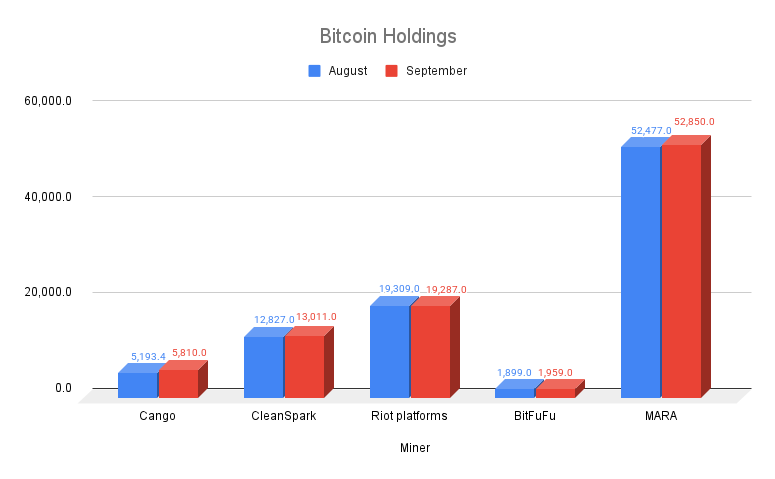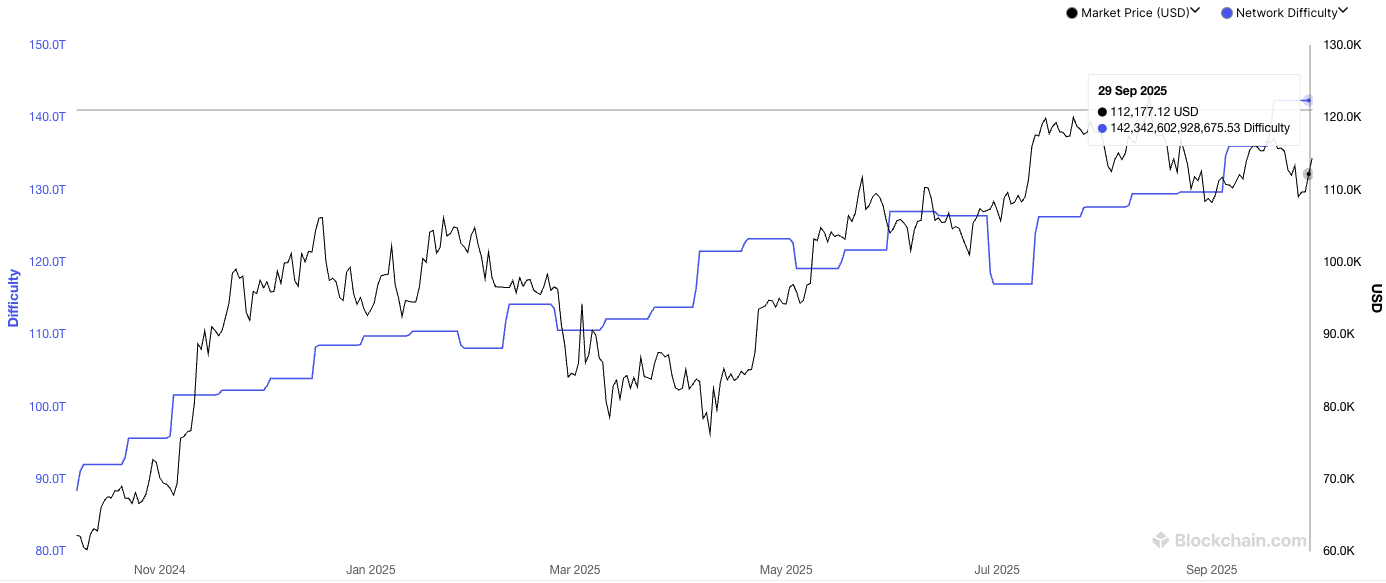Bitcoin Production in September Softens Amid Rising Difficulty — MARA Maintains Lead
September’s surge in Bitcoin mining difficulty squeezed profits across the sector, yet Marathon Digital (MARA) maintained its production lead. With efficiency now defining success, smaller miners face a challenging path amid rising costs and shrinking rewards.
Competition in the Bitcoin mining sector intensified in September 2025 as mining difficulty reached new all-time highs, while production across most major miners declined.
Large-scale companies with strong balance sheets and accumulation strategies continued to thrive in this environment, whereas smaller miners faced growing pressure from operational costs and technical volatility.
Bitcoin Production Declines as Difficulty Rises
According to publicly released reports, Cango mined around 616 BTC in September, down from 663 BTC in August.
CleanSpark produced 629 BTC, a slight dip from the previous month. Riot Platforms generated 445 BTC, compared to 477 BTC in August. BitFuFu’s output dropped sharply to 329 BTC, while Marathon Digital Holdings (MARA) maintained its lead with 736 BTC mined, further expanding its Bitcoin reserves.
 Bitcoin production by major mining companies. Source: BeInCrypto
Bitcoin production by major mining companies. Source: BeInCrypto
The data suggests that while larger miners managed to keep their production relatively stable, smaller operators began to feel the strain from rising difficulty and energy costs.
 BTC holdings of selected companies. Source: BeInCrypto
BTC holdings of selected companies. Source: BeInCrypto
Meanwhile, Bitcoin’s network difficulty climbed to 142.34T in September, marking a new all-time high. This consistent increase in difficulty means that each unit of hashrate now yields fewer BTC, driving hashprice (revenue per unit of computational power) lower.
As a result, miners’ profit margins continue to tighten, especially for those with higher energy costs or less efficient hardware.
 Bitcoin mining difficulty. Source:
Blockchain.com
Bitcoin mining difficulty. Source:
Blockchain.com
Notably, a new anti-Bitcoin mining bill in New York recently proposed a progressive tax on Bitcoin mining companies, with revenue redirected to lower utility bills for residents. The bill faces uncertain prospects but could disrupt multi-billion-dollar data center plans and increase cryptocurrency regulation in the state.
In summary, Bitcoin production in September revealed mounting technical pressure on the mining industry. As difficulty keeps rising and profit margins shrink, large miners like MARA, which have efficient infrastructure and a strategy of BTC accumulation, remain in a strong position.
Smaller firms must carefully consider selling BTC, cutting power capacity, or scaling operations to navigate the increasingly competitive and volatile landscape.
Disclaimer: The content of this article solely reflects the author's opinion and does not represent the platform in any capacity. This article is not intended to serve as a reference for making investment decisions.
You may also like
XRP News Today: Ripple Alerts Users to XRP Fraud as Crypto Faces Volatility from Fed Actions
- Ripple warns XRP holders of scams amid crypto market sell-offs, citing fake streams and "doubling" schemes during its Swell conference. - XRP price drops to $2.29 as Bitcoin ETF outflows and Fed rate uncertainty deepen sector-wide volatility and investor caution. - Despite $500M institutional funding, Ripple faces deepfake phishing risks, urging vigilance against impersonation tactics targeting its community. - Market fragility persists with 45.9% of investors now expecting a December Fed rate cut, down
Zcash (ZEC) Value Soars Amid Changes in Privacy Regulations
- Zcash (ZEC) surged 472% to $683.14 in 2025, driven by regulatory clarity, institutional adoption, and tech innovation. - U.S. Clarity/Genius Acts validated privacy coins, enabling Zcash's optional transparency model to align with AML requirements. - Grayscale's $137M ZEC allocation and Cypherpunk's $50M treasury highlight institutional confidence in Zcash's compliance-ready privacy framework. - Zashi Wallet's protected swaps and Zcash's AML-compliant design differentiate it from blacklisted mixers like T
The DASH-USDC Stablecoin Peg Turmoil: An Urgent Alert for Stablecoin Holders
- The 2025 DASH-USDC depegging exposed systemic risks in stablecoins, mirroring 2023’s USDC-SVB crisis and algorithmic failures. - DeFi platforms like Aave face cascading liquidations during collateral drops, highlighting vulnerabilities in leverage-driven models. - The Genius Act aims to regulate stablecoins but overlooks DeFi risks, leaving arbitrageurs to navigate fragmented compliance frameworks. - Investors are urged to prioritize transparent collateral-backed stablecoins and avoid over-leveraged DeFi
DappRadar closes its doors, the RADAR token collapses by 30%

